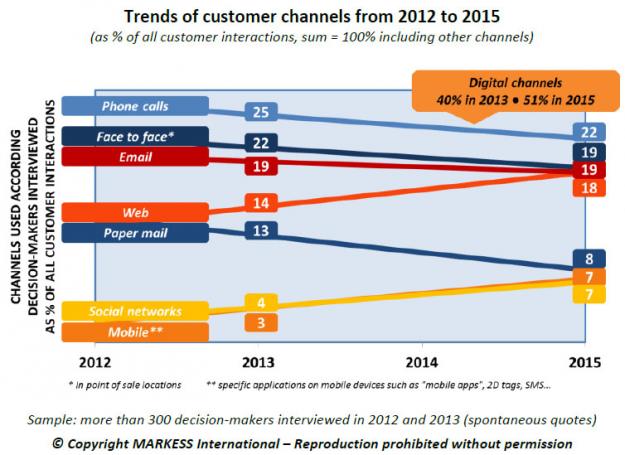Finding the key to managing cross-channel customer service

Customers want to interact with companies on an ever-widening number of channels. And while newer channels such as mobile and social media may currently be hitting the headlines, it is vital that customer service teams don’t neglect traditional communication methods such as email, the web and phone.
In fact, the total number of contacts, across every channel, is increasing. A recent study by market researchers MARKESS International found that the volume of customer interactions was increasing by 5% per year. The 2013 MARKESS research, carried out in conjunction with Eptica, surveyed 145 business and IT decision makers in France and highlighted the global shift to digital channels.
Companies predicted that by 2015 over half (51%) of contact would be through digital channels (web, email, mobile, social), with the fastest growing channels being:
- The web - up from 14% of contacts in 2013 to 18% in 2015
- Mobile - more than doubling from 3% to 7%
- Social networks - increasing from 4% to 7% over the same period
In our experience the UK market is seeing similar trends. So, while digital will have the upper hand, traditional channels such as telephone, post and even face to face won’t be going away anytime soon. Organisations therefore need to be able to handle more interactions across more channels without impacting customer satisfaction or efficiency. They have to transform their operations to work cross-channel in an era where change is the only constant.
The good news is that 56% of those surveyed believed that their customer service budgets dedicated to digital would increase, although 38% weren’t able to predict whether budgets would go up or down.
To meet future needs, the decision makers interviewed by MARKESS were focusing their cross-channel strategies on four areas:
- Integration of all channels (digital and traditional) through a single strategy and team to drive efficiency and customer satisfaction.
- The establishment of a single, centralised contact process to ensure cross-channel consistency. This should span all customer interactions, including contact management, orders and logistics.
- The creation of metrics to measure the value of digital customer interactions so they can be compared to traditional channels.
- Strong involvement of the CIO in any mobile customer interaction projects to ensure their success.
While the MARKESS research focused on France, it uncovers similar issues and areas for focus as in the UK. At a time of unprecedented competition, organisations need to achieve a balance between channels – delivering the same high standards of customer experience however they are contacted.







Comments